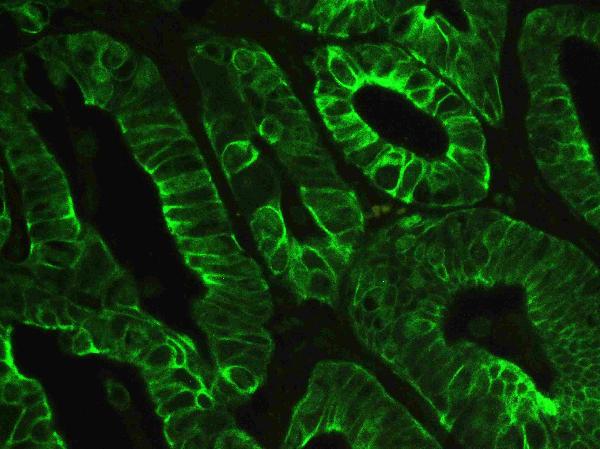Product Info Summary
| SKU: | BA1120 |
|---|---|
| Size: | 0.5ml |
| Application: | Flow Cytometry, IF |
Product info
| Product Name | FITC Conjugated Protein A |
| SKU/Catalog Number | BA1120 |
| Pack Size | 0.5ml |
| Form | Concentrated, Liquid |
| Concentration | 1 mg/mL |
| Description | Protein A is a 42 kDa surface protein originally found in the cell wall of the bacteria Staphylococcus aureus. It is encoded by the spa gene and its regulation is controlled by DNA topology, cellular osmolarity, and a two-component system called ArlS-ArlR. It has found use in biochemical research because of its ability to bind immunoglobulins. It is composed of five homologous Ig-binding domains that fold into a three-helix bundle. Each domain is able to bind proteins from many mammalian species, most notably IgGs (Table 1). It binds the heavy chain within the Fc region of most immunoglobulins and also within the Fab region in the case of the human VH3 family. Through these interactions in serum, where IgG molecules are bound in the wrong orientation (in relation to normal antibody function), the bacteria disrupts opsonization and phagocytosis. Recombinant Protein A is produced in E.coli and essentially functions the same as native Protein A. Protein A may be conjugated with various reporter molecules, including fluorescent dyes (FITC), enzyme markers (peroxidase, b-galactosidase, and alkaline phosphatase), biotin, and colloidal gold without affecting the antibody binding site on the molecule. These conjugates are used to detect immunoglobulins in various immunochemical assays including Western blotting, immunohistochemistry, and ELISA applications. |
| Contents | 0.5 mg of FITC conjugated protein A, F/P=3/1; 0.01M PBS; 50% glycerol. |
| Labeling Method | Protein A is conjugated to FITC by means of a method described by Hijmans,W.,et al. (Reference: Hijmans,W.,et al. Clin.Exp.Immunol.,4, 457 (1969)) |
| Storage & Expiration | At -20°C for one year from date of receipt. Avoid repeated freezing and thawing. Protect from light. |
| Applications | IF, Flow Cytometry |
| Cite This Product | FITC Conjugated Protein A (Boster Biological Technology, Pleasanton CA, USA, Catalog # BA1120) |
Product Images
Validation Images & Assay Conditions

Click image to see more details
PCK was detected in paraffin-embedded sections of human intestinal cancer tissues using mouse anti-PCK Antigen Affinity purified monoclonal antibody (Catalog # MA1081) at 1 μg/mL. FITC Conjugated Protein A (Catalog # BA1120) was used to detect the primary antibody at 20μg/mL.
Specific Publications For BA1120
Hello CJ!
BA1120 has been cited in 13 publications:
*The publications in this section are manually curated by our staff scientists. They may differ from Bioz's machine gathered results. Both are accurate. If you find a publication citing this product but is missing from this list, please let us know we will issue you a thank-you coupon.
Development and evaluation of lipid microbubbles targeted to alpha(v)beta(3)-integrin via biotin–avidin bridge
Tween-20 transiently changes the surface morphology of PK-15 cells and improves PCV2 infection
Heat shock protein 90 is essential for replication of porcine circovirus type 2 in PK-15 cells
Hsp70 positively regulates porcine circovirus type 2 replication in vitro
PCV2 infection activates the cGAS/STING signaling pathway to promote IFN-β production and viral replication in PK-15 cells
RIG-1 and MDA-5 signaling pathways contribute to IFN-β production and viral replication in porcine circovirus virus type 2-infected PK-15 cells in vitro
Protection of pigs against post-weaning multisystemic wasting syndrome by a recombinant adenovirus expressing the capsid protein of porcine circovirus type 2
Development of recombinant porcine parvovirus-like particles as an antigen carrier formed by the hybrid VP2 protein carrying immunoreactive epitope of porcine circovirus type 2
Construction and immunogenicity of recombinant adenovirus expressing the capsid protein of porcine circovirus 2 (PCV2) in mice
Inhibition of replication of classical swine fever virus in a stable cell line by the viral capsid and Staphylococcus aureus nuclease fusion protein
Customer Reviews
Have you used FITC Conjugated Protein A?
Submit a review and receive an Amazon gift card.
- $30 for a review with an image
0 Reviews For FITC Conjugated Protein A
Customer Q&As
Have a question?
Find answers in Q&As, reviews.
Can't find your answer?
Submit your question


